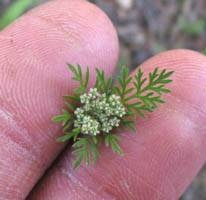| Daucus pusillus | |
|---|---|
 | |
| Scientific classification | |
| Kingdom: | Plantae |
| Clade: | Tracheophytes |
| Clade: | Angiosperms |
| Clade: | Eudicots |
| Clade: | Asterids |
| Order: | Apiales |
| Family: | Apiaceae |
| Genus: | Daucus |
| Species: | D. pusillus |
| Binomial name | |
| Daucus pusillus | |
| Synonyms [2] | |
| |
Daucus pusillus is a species of wild carrot known by the common names American wild carrot [3] and rattle-snake-weed. [4] Its Latin name means "little carrot", or "tiny carrot". It is similar in appearance to other species and subspecies of wild carrot, with umbels of white or pinkish flowers. [5] The taproots are small, edible carrots. It should not be confused with Conium maculatum , which is highly poisonous. [6]

